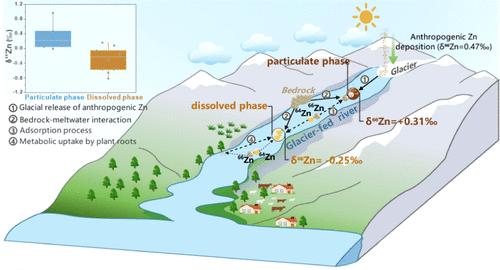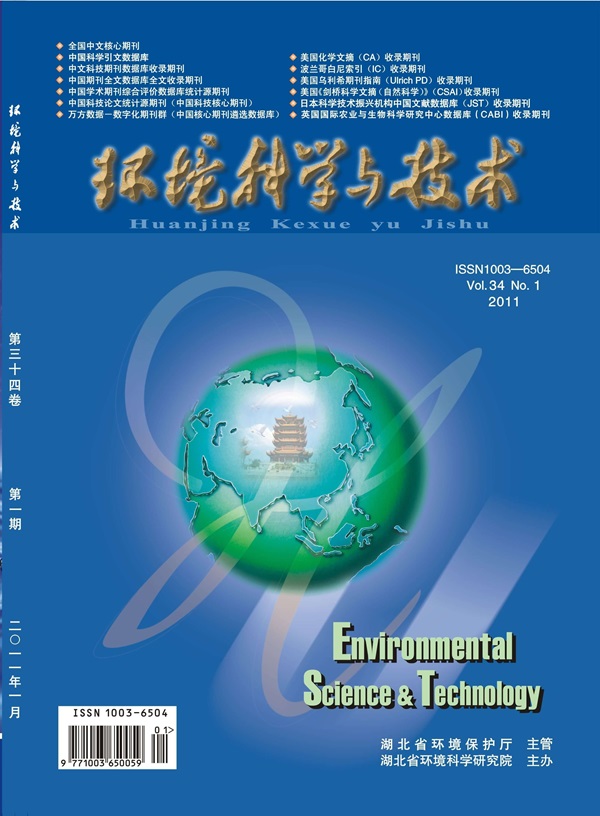Zn Isotopic Composition Variability in Glacier-Fed Alpine Rivers of the Northeast Tibetan Plateau: Response to Migration Processes and Anthropogenic Impacts
IF 11.3
1区 环境科学与生态学
Q1 ENGINEERING, ENVIRONMENTAL
引用次数: 0
Abstract
Elucidating the migration processes of zinc (Zn) is crucial for comprehending its influence on global biogeochemical cycling. However, significant gaps remain in the knowledge of these processes in glacier-fed rivers of the northeast Tibetan Plateau (NETP). This study determined the isotopic compositions (δ66Zn) of dissolved and particulate Zn in three alpine rivers fed by the Laohugou Glacier (LHG), the Lenglongling Glacier (LG), and the Yuzhufeng Glacier (YG) in the NETP. Results show that the δ66Zn of particulate Zn varies from −0.01 ± 0.04 to +0.97 ± 0.12‰, generally higher than that of dissolved Zn (−0.82 ± 0.06 to +0.19 ± 0.03‰). This suggests a migration behavior in which isotopically lighter Zn is enriched in the dissolved phase and isotopically heavier Zn preferentially adsorbs onto the particulate matter. Moreover, the δ66Zn in the dissolved phase exhibits obvious spatial variation, with an upward trend from the LHG-fed river to the YG-fed river and subsequently to the LG-fed river. In contrast, this trend is less pronounced in the particulate phase due to an anomalously high δ66Zn value (0.97 ± 0.12‰). This isotopic anomaly is primarily attributed to anthropogenic impacts. A comparison with global terrestrial aquatic environments emphasizes the unique response of Zn isotope variability in NETP glacier-fed rivers to both migration processes and anthropogenic impacts.

青藏高原东北部冰川哺育的高山河流的锌同位素组成变异:对迁移过程和人为影响的响应
阐明锌(Zn)的迁移过程对于理解其对全球生物地球化学循环的影响至关重要。然而,对青藏高原东北部(NETP)冰川哺育河流中锌(Zn)迁移过程的了解仍存在巨大差距。本研究测定了青藏高原东北部老湖沟冰川(LHG)、冷龙岭冰川(LG)和玉珠峰冰川(YG)注入的三条高山河流中溶解锌和颗粒锌的同位素组成(δ66Zn)。结果表明,颗粒锌的δ66Zn变化范围为-0.01±0.04至+0.97±0.12‰,普遍高于溶解锌(-0.82±0.06至+0.19±0.03‰)。这表明了一种迁移行为,即同位素较轻的锌富集在溶解相中,而同位素较重的锌则优先吸附在颗粒物质上。此外,溶解相中的δ66Zn 表现出明显的空间变化,从 LHG 注入的河流到 YG 注入的河流,再到 LG 注入的河流,δ66Zn 呈上升趋势。相比之下,由于δ66Zn 值异常高(0.97 ± 0.12‰),这种趋势在微粒相中并不明显。这种同位素异常主要归因于人为影响。通过与全球陆地水生环境的比较,我们可以看出,NETP冰川注入河流的锌同位素变异对迁移过程和人为影响都有独特的反应。
本文章由计算机程序翻译,如有差异,请以英文原文为准。
求助全文
约1分钟内获得全文
求助全文
来源期刊

环境科学与技术
环境科学-工程:环境
CiteScore
17.50
自引率
9.60%
发文量
12359
审稿时长
2.8 months
期刊介绍:
Environmental Science & Technology (ES&T) is a co-sponsored academic and technical magazine by the Hubei Provincial Environmental Protection Bureau and the Hubei Provincial Academy of Environmental Sciences.
Environmental Science & Technology (ES&T) holds the status of Chinese core journals, scientific papers source journals of China, Chinese Science Citation Database source journals, and Chinese Academic Journal Comprehensive Evaluation Database source journals. This publication focuses on the academic field of environmental protection, featuring articles related to environmental protection and technical advancements.
 求助内容:
求助内容: 应助结果提醒方式:
应助结果提醒方式:


